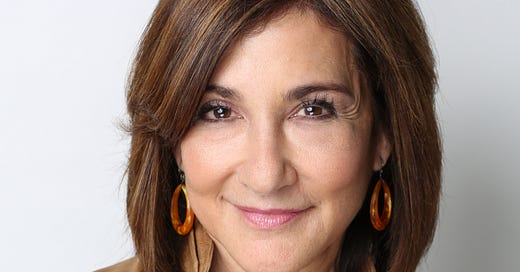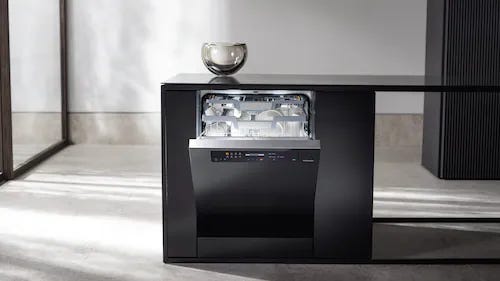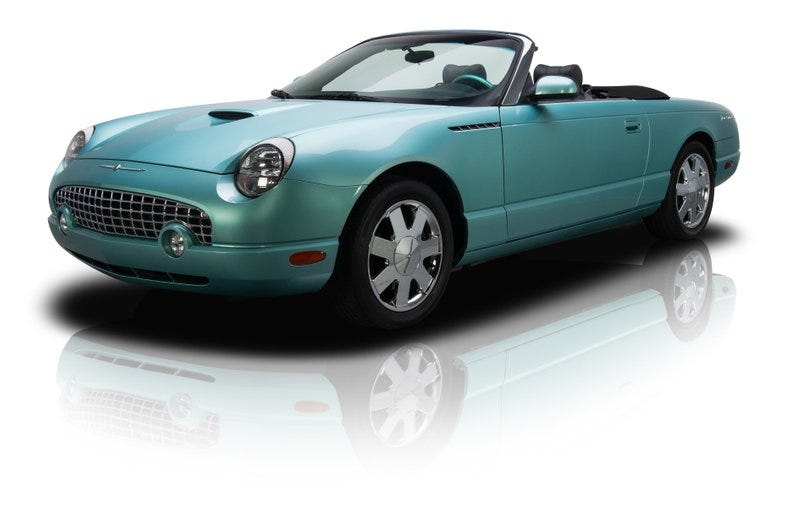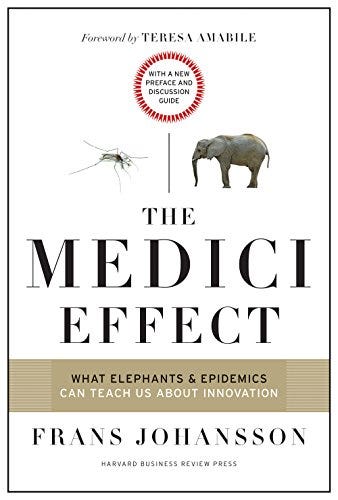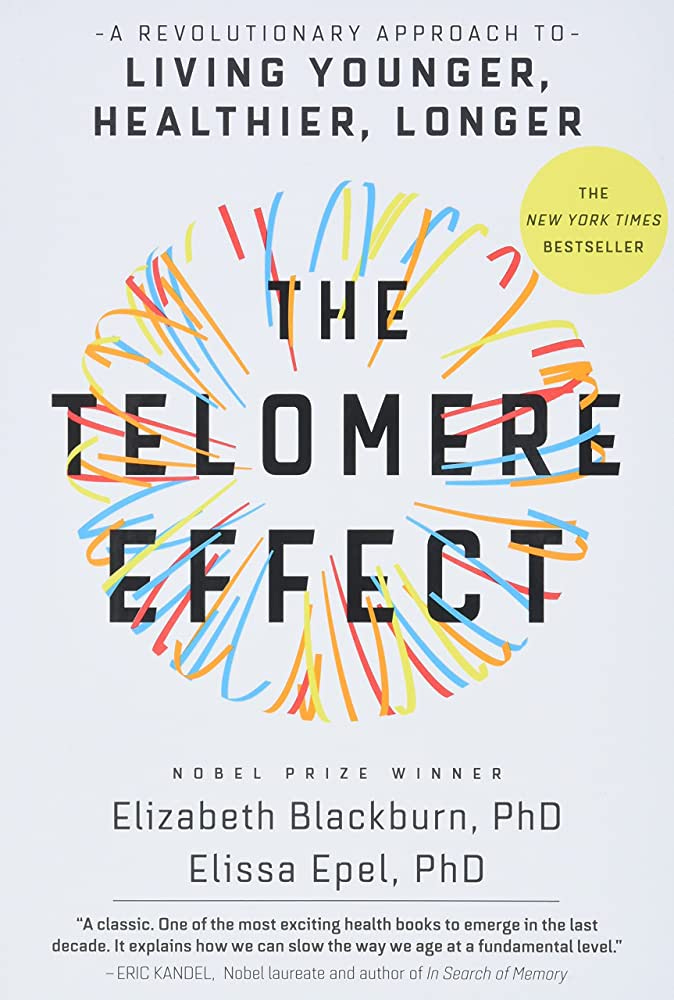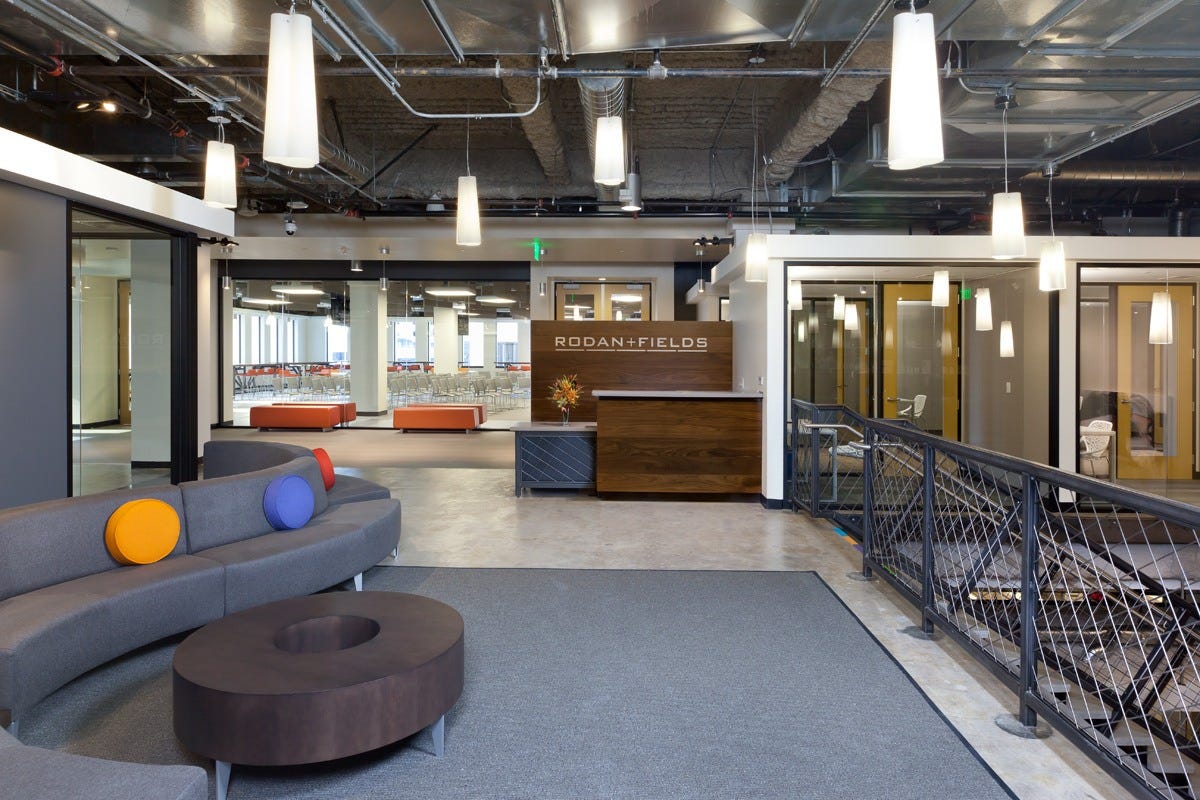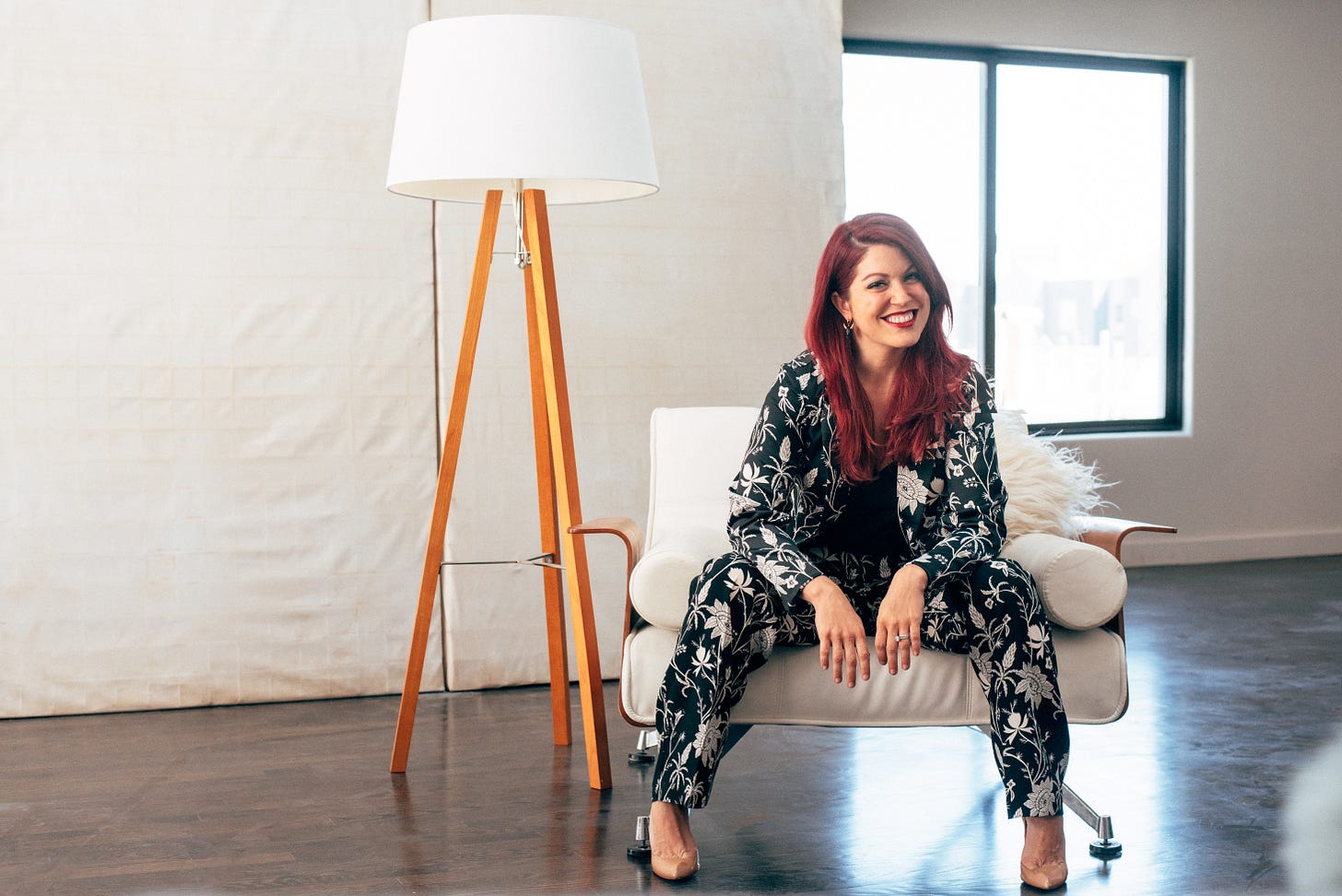👋, I’m Kimberly. I’ve been creating obsession-worthy brands for the past fifteen years. And now, I’m giving away my secrets every week in this newsletter.
Welcome to the Secrets of… Series — in which I’ve carefully designed a series of thought-provoking questions to tease the most interesting and insightful information out of the best brand builders in the world.
Do you have someone in your life who always makes you think, “Wow, I am so lucky to know you”?
For me, Lori Bush is that person. Lori Bush is one of the most perceptive, motivated, and caring people you’ll ever have the pleasure to know — both in business and on a personal basis.
I first worked with Lori at Rodan + Fields, in her role as the CEO who had led the company into the direct selling channel. At the time of her retirement in 2016, the company was valued at $1.5 billion with continuing high double-digit YoY revenue growth.
Then, I worked with Lori again when she started up Solvasa, a new company and a new category in wellness she calls integrative beauty. This kind of ambitious venture is what Lori refers to as “retirement.”
And I’d happily take any opportunity to work with Lori again in the future, because not only does she build the most inventive and compelling brands, but she always teaches me something along the way.
I spent the day with Lori at her welcoming home in Sonoma, where she and her husband also make wine, and olive oil, and own one of the best restaurants in town. And I’m thrilled to bring you her insights in two parts (because one newsletter simply could not contain them).
Helping people to live better longer by developing an integrated approach to consumer health and beauty care has not only been Lori Bush’s career, but also the source of her passion for nearly 35 years.
In May of 2020, Bush launched Solvasa, a company inspired by her post-retirement experience with breast cancer and based on recognition of macro trends with unmet needs in the areas of beauty and wellbeing.
In October, 2007, Bush partnered with the founders of Rodan + Fields, to lead the company’s pivot out of department stores and into the direct selling channel. As Chief Executive Officer, Bush took the company from re-stage to the largest independent premium skincare brand in the U.S.
Prior to joining Rodan + Fields, Bush served as President of Nu Skin, the global personal care division of Nu Skin Enterprises, worked at Johnson & Johnson Consumer Products Companies as the Worldwide Executive Director over Skin Care Ventures, and served as the Vice President of Professional Marketing for Neutrogena.
1. How would you explain what you do to someone who has no idea?
I invent things – primarily products, but sometimes practices or processes that help people live a little more beautifully, a little bit better, and maybe a little longer. That’s always been my mission.
What’s your favorite thing you’ve ever invented?
The first thing I invented as part of my job was a laboratory test for a hereditary condition that affects your blood and its platelets. It was a condition called von Willebrand Disease and, at the time, most laboratories couldn't test for it.
The thing about von Willebrand Disease is that it's not that rare, but milder forms are oftentimes not diagnosed. If you're about to have surgery, it’s important to identify it because there is a risk of increased bleeding.
Right out of college, I was working in a medical laboratory, and I was assigned the responsibility to set up the von Willebrand’s assay for my lab. I went to the Mayo Clinic, then I went to the CDC, then I went to a University Hospital in Philadelphia — and I found that each place did the test for von Willebrand disease in a different way.
I'm good at finding shortcuts. And by looking at all of the tests and taking the best parts of each, I was able to create a way to do it faster and easier.
It became a big revenue generator for the lab, and we conducted studies for publication using the test I developed. I presented one of the studies at a conference, and it seemed that nobody really cared about the study. The only question I would get asked is, "How did you do the test for Von Willebrand disease? We want to do it."
After that, I was hired by a small company to work in product development. They had their list of things they wanted me to work on, but I said, "I have this idea about how to make a commercial kit for the diagnosis of von Willebrand Disease."
They said, "Well, if you want to work on that in your spare time…"
So I would stay after hours and tinker. One day, I emerged from the lab. and I said, "Okay, I think I've got it!"
For my career development, this was a big deal. I got to do everything from start to finish, and the product was a huge success. It doubled the revenue of the company, but as a junior-level employee, I didn’t make any meaningful money as a result of it. The year was 1981, and I had a salary of $17,000 a year and received a $250 bonus. But the test became a new industry standard, and other big companies tried to knock us off and couldn’t do it.
That experience made me want to create things that were filling an unmet need — and that's how I've approached everything from a product perspective. I have no energy for doing “fast-follower” stuff or making and marketing what everybody's already buying. I'm the anti-benchmarking queen.
As soon as you start talking about benchmarking — unless you're benchmarking against yourself for a next-generation improvement — you're capping innovation.
2. One of my favorite quotes about branding is this one from Wally Olins:
Fundamentally, branding is a manifestation of the human condition. It is about belonging; belonging to a tribe, to a religion, to a family. Branding demonstrates that sense of belonging. It has this function for both people who are part of the same group and also for the people who don’t belong.
What brands have made you feel like you personally belong in your lifetime? These could be brands you belong with right now—or in the past (say, when you were a teenager).
Before I answer the question, I want to talk about the quote.
What I love about that quote is that there is also an aspect of people who don't subscribe to a particular brand and identify as a non-follower.
One of the first things that went through my head was “I'm not a Peloton person.” It's not that I'm not physical and athletic, I've just never jumped on the bandwagon and that has made me feel like I belong to a segment of the population that doesn’t connect to exercise via Peloton.
I’m also not a Lululemon person, either. I'm Athleta and it seems that being Athleta is more about being a little anti-Lululemon, maybe?
But how do I identify myself? What do I see myself connected to?
One thing is my 1994 Land Cruiser. That old, kind of badass car might not be what you would expect me to be driving. It's not the car I drive the most. She’s old and has needed a lot of work through the years, but she’s still got a cool vibe about her. So I guess the way I describe her is the way I want to think of myself.
Lately, kitchen appliance brands have become a thing for me. I've become an evangelist for Miele Dishwashers. And I’ve found that people who have Mieles are adamant about them. They clean so well — but they also have these lights inside, so when you open your dishwasher, everything sparkles. Get a life … right?!
I identify with lifestyle brands that connect me to food and cooking: Wolf appliances, Le Creuset cookware, William Sonoma, and Whole Foods Markets. If I were choosing a designer brand, the one that I connect with the most is David Yurman.
I admit I kinda like it when people recognize my loyalty to certain brands. It’s like the brand becomes part of my DNA code. Like Doc Martens and UGG for footwear.
Doc Martens? I would not have tagged you as a Doc Martens person.
But look where I live here in Sonoma! I used to be all about stilettos and was known for not wearing the same thing twice in a year. Now I wear the same thing every day.
When I'm out and about in the vineyard or in our cute little town square, give me a pair of leggings, a fun hoodie, and Doc Martens and I'm good to go.
It's my wine-country look. I don't have a single pair of Doc Martens down in Manhattan Beach, though. I have a whole different vibe down there.
It’s interesting that you have different brands in different places…
When I'm down in Manhattan Beach, I have a turquoise 2002 Thunderbird convertible. Isn't that a perfect LA car?
I have a whole different wardrobe. You might see me in a pair of Gucci shoes. That's where you'll see a lot of my Yurman jewelry coming out, and my appliances are not a big deal to me down there. It's a different place and a different version of me.
My husband is the same way. We think of ourselves almost as different people when we're down at our Manhattan Beach house, versus when we're up here in wine country.
3. What event or interaction in your life has most shaped who you are today in your work?
I was encouraged to pursue a STEM career because I did well in math and science. I started off as pre-med. But that was other people trying to shape me; that’s what led me to pursue a degree in medical technology at Ohio State. But throughout my clinical laboratory training, I would find myself thinking "There's an easier way to do this. There's a better way to do this." So I would create my own version of a laboratory test — and I'd come up with the right answer, and I'd come up with it faster.
I had people who loved me for it, but there were others, mostly instructors, who would shut me down for it. I'd get in trouble, and they would say, "Go back to the bench and follow the instructions to the letter.”
That's when I realized I couldn't be a medical technologist — and I couldn't do anything where I had to have this much precision around following a particular rule.
It's interesting when you work with people who need that sort of rigor in how they do things. Not everybody is looking for a new path, a better idea, or a better way. A lot of people just want to follow a particular template and we need those people, too, but I wasn’t one of them.
4. What is the marketing-related book you would gift to someone who isn’t in marketing? And what is the non-marketing-related book that’s had the most impact on you as a marketer?
My Marketing-Related Book:
The Medici Effect
When I find myself stuck, one of my tricks is to pick up a random book — one that has nothing to do with my current problem — and open it to a page. Then, I read a paragraph and try to make a connection to what I'm working on.
This simple act opens up new thinking channels and can lead to unexpected solutions.
That's why "The Medici Effect" is one of my favorite books. It’s all about finding answers at the intersection — getting out of your own way and popping your head up and looking for answers and solutions and ideas in counterintuitive places.
And it shows how diversity in thinking and ideas doesn't necessarily mean just racial diversity or gender diversity; it also means diversity in backgrounds and cultures and experiences.
I was already predisposed to this kind of thinking. The book supports it and offers a lot of practical examples of how it has worked throughout history.
A few years ago, I gave a keynote at the winter commencement of Temple University, my graduate school. I wanted my message for the graduates of the business school to be about going forth in the world in a way that their careers and their lives will both be richer if they allow them to intertwine a bit.
A lot of the big ideas or solutions to problems are going to come from the most unexpected places. You should always be mashing things up.
My Non-Marketing-Related Book:
The Telomere Effect by Dr. Elizabeth Blackburn
I didn't buy into a lot of things about mindfulness. I always thought it was very woo-woo and who has time to sit on a cushion and meditate for 40 minutes?!
Then I started reading The Telomere Effect. Dr. Elizabeth Blackburn is a Nobel Prize winner, and this book was given to me by a friend of hers. It made a very scientific, validated, clinically proven connection between mindfulness and health and longevity and cellular health. It was undeniable.
I thought I was healthy, but I also thought, “I'll sleep when I'm done! I eat stress for lunch, and who has time for contemplating their naval?”
After I read The Telomere Effect, I started to appreciate how deleterious some of my lifestyle habits were to my health. It could very well have been the reason I ended up with a little lump in my breast.
My career in beauty and skincare spanned over 30 years, and I always stressed the importance of wellness and longevity. One of my stump speeches was about 10 Strategies for Wellness and Longevity — and my number 10 was always, "Take care of your skin, and it'll take care of you."
But I compartmentalized everything. Managing stress was in one bucket. Mindfulness and healthy nutrition were in another. And I started to realize that all of those things were necessary for healthy, beautiful skin — and it was about putting it all together.
The Telomere Effect made me think, "Holy crap, I kind of screwed myself for 60 years!”
So now, when it comes to marketing products in the beauty and wellness category, I’m all about the interconnectedness. I want everybody to appreciate that little changes can make a big difference.
While you're waiting for your coffee to brew, you can do a little micro-meditation. And guess what? It doesn't take up more time, and it makes your whole day more productive.
I love The Telomere Effect.
5. You're getting put into the Marketers Hall of Fame. What campaign do you want to be remembered for?
There are two things. And they're very different. One is very cultural and the other is operational.
The first thing that I'm the proudest of these days is the set of business values that I instilled in Rodan + Fields.
Having started with the company basically from ground zero, these values were all based on early observations of the times when we were firing on all cylinders: what was in play helping us succeed and what was missing when we missed. And a lot of those things were cultural.
At Rodan + Fields at the time, our logo was a color bar and all of the different skincare regimens had a specific color.
I tied each of our business values to a color — and we called them our True Colors Business Values. We galvanized around those values, recognizing them and rewarding them.
Each year, we had employees nominate and recognize the person they thought most represented the True Colors Business Values. And we would play and sing the Cindy Lauper song True Colors. Even now, whenever I hear that song, I cry thinking about what a beautiful culture we built for our company.
The business values weren't intuitive… or the things everyone assumed they would be.
For example, everybody says, "What about things like trust?"
And I say, "Trust is not something you say; it’s something you earn. And if you have to say you’re trustworthy, you’re probably not.
Or one might ask, "What about integrity?" '
And I say, “If I have to say integrity is important, I've really screwed up on some level.”
I’ve carried these business values with me; they’re almost always relevant and when I share them most agree and say, "Well, these should apply to every business."
The first value is assurance.
I wanted to call this value predictability, but people think predictability sounds boring. Assurance is about consistently delivering on your promises.
That was very important for building a brand. You can’t show up one day as one thing and the next day looking like something else.
This was especially important because of our business model being direct selling. We built a community around a great product concept, so we needed to protect that and never succumb to the unsavory business practices that would make us a pyramid scheme.
We needed to stay true to who we were as a company, a brand, and a business opportunity. Loyalty comes from consistently delivering on your promises.
The second value is business savvy.
Business savvy means getting inside the head of your customer: knowing who your customer is and what's important to that customer.
You can devalue some things in certain businesses because they're not important to your customer whereas other things may be uber important.
People often drag along what they know from prior companies or personal experiences without truly understanding the new constituency. But when I'm talking to the trade customer, I'm not necessarily promoting the same aspects of a product as when I’m talking to the end consumer.
Business savvy is not just understanding your product; it’s understanding your brand and how it connects to your customer as well as everybody else, including your employees and investors.
The third value is collaboration.
I have always felt that we could solve any problem when we put our heads together to get diversity in thinking.
So often I see people in business thinking “I could solve this problem before anybody knows about it!” And they put their heads down until it explodes on them.
And I think, "Why did you leave yourself holding the bag instead of sending up a red flag earlier on?"
When we built out the headquarters for Rodan + Fields, the thing that I felt was the most important was having a staircase in the center of the building, between all of the floors. That was one of the criteria for finding a building. And I found out later I was actually on-trend.
Our initial offices on Maiden Lane in San Francisco were in a small building. And as we were growing, we extended our office space to multiple floors. The only way you could get from floor to floor, even if it was just one floor, was in an elevator.
When we went from all being on one floor to having two floors, we didn't talk to each other in the same way. Instead of talking face to face, people would email. They wouldn't collaborate in the same way. So that was one of the things I was looking for — one big floor.
Unfortunately, I couldn't find a building where you wouldn’t need roller skates if all the offices were on one floor. So the staircase became very important. We also had “idea paint” on all the walls, so you could huddle with people almost anywhere and use the walls as a white board to capture ideas.
That was all about collaboration.
The fourth value is innovation.
We defined this in two ways – one being the daily innovation that comes from keeping your ear to the ground.
At Rodan + Fields, I found that the people who were our ears were those in our call center. In most companies, the call center is considered a cube farm and there’s high burnout. But our call center was energized because the team knew they were important to us.
When Rodan + Fields was small, I started meeting with the call center team once a week. I would say, "What are you hearing? What are the problems we need to solve — and how can we creatively solve them?"
Many of the things I found that we could do better were not bubbling up unless you deliberately asked somebody.
Keep your ear to the ground and find those little incremental things that you can do.
Sometimes the solutions to the problems were so simple.
As we grew larger, I tried to pull the executive team into the whole mix of listening and with some there was resistance, as though it was below their paygrade.
Listening is something you think, “I'm going to go pay a market research group to do.” But the listening that you do is so much more powerful.
Yammer was our internal social site to communicate with everybody. We innovated a program that utilized Yammer that was even ultimately used as a case example of how Yammer solved our business need in a meaningful way.
The idea for innovating on innovation came to me one day when I sat in the call center, side-by-side with the support team, and answered the phone. For almost every call, when I went to our knowledge base for the programmatic answer, something didn't make sense to me. So I would ask somebody from the call center staff, "Why are we doing this, this way?"
And usually they would say, "I've always wondered that myself, because it doesn't make sense."
A lot of things that were initially workarounds had become institutionalized for some reason — and nobody realized it, and nobody thought to ask why.
I set up a page on Yammer that I called “Ask Why” and invited everybody in the company to post questions about why we did things the way we did. I got a lot of resistance initially from my top team, but I said, "I want people to feel empowered to ask why when they see us doing something that doesn't make sense to them."
They said, "People are going to just complain and they're going to ask for things that aren't material."
I said, "No, I have more confidence in the intention of our employees and want to foster a conversation where anybody can answer or put another spin on the issue."
And ultimately, what we implemented had real impact. We rewarded people for asking and for participating in the conversation. We would make word clouds out of the issues that were bubbling up the most, and we brought in a group called Social Lair with an application to gamify the quarterly “jam sessions” we held for problem-solving.
We would put together teams of the employees who engaged in the conversations on the Ask Why page. The teams would be a mixture of executives, managers, and employees throughout the organization. It also gave us a chance to see where we had hidden talent. Teams would get virtual currency. They'd come up with solutions and present them, and then invest in the various solutions that were presented. They couldn't invest in their own ideas, only in others.
Everyone on the winning team got a lightbulb trophy, and we made a point to implement the winning idea to whatever extent we could.
That became a meaningful aspect of our culture; the opportunity for everyone to innovate better ways to build our company.
The other aspect of innovation is the big idea that transforms business, a product category, and people’s lives.
Transformational innovation, finding that blue ocean opportunity, or a new way of doing things comes from keeping your tentacles out there — getting out of your workspace or your discipline and engaging in big ideas.
Agility and ideas and development come from people and interactions much more than from tools and processes. For me, that meant engaging with other CEOs and attending conferences and events that at first blush maybe didn't seem like anything related to my work. But getting myself out there, even when it was inconvenient, gave me the opportunity to meet new people and expand my network.
The other thing I’d want to be remembered for was more operational — and that would be writing the book "Write Your Skin A Prescription For Change."
We were starting a new company with two dermatologists who had their own brand equity; they had a brand called Proactiv Solution that was very tied to acne. And we had to transition their personal brand from being “The Acne Chicks” to being the visionaries who made clinical skincare accessible to all.
And so I had an idea to write a book and make that book a bestseller.
The doctors already had a manuscript, but it was not publication-ready. So I hired a writer to work with the doctors. Then I got the book back, and it was boring! The doctors have so much personality, and the book didn’t have their voice.
At the time, my son had just graduated from high school, and the graduation gift he wanted was a trip to Scotland. He picked the one place in the world that has more miserable summer weather than San Francisco to go on vacation.
So there we were in Scotland, and it was dreary and drizzly. And my son and husband who wanted to be there both spent a lot of time sleeping, because it was great sleeping weather.
So I thought, "Okay, I'm going to start editing this book.” And as I'm editing it, I thought, "This just doesn't sound like my awesome doctors."
I rewrote a couple of chapters and sent the rewrite to Katie Rodan, and I said, "This is the direction I think this book should go."
She said, "You're right. You need to rewrite the whole thing." That’s how I ended up becoming a co-author for a bestseller.
Collaboratively, we rewrote the whole book. And we did some fun things to bring clinical skin care to life in an approachable way. We created imagery where we photographed models and overlaid skin conditions onto their faces. We made it very clear that these aren't real before and afters, but you could see what a person looks like with a particular skin condition versus not having the condition. It was a great project.
We crowdsourced the purchase of the book amongst our sales organizations, so we were able to get a number-one bestseller in several categories right out of the blocks — which is always a good thing to have on the cover!
Then, we did a book tour with the doctors, and we used that to develop brand awareness and recruit our sales organization. We also made good use of a lot of the book’s fun soundbites for building our brand.
To further socialize our brand values in a unique way, we started doing webisodes on Facebook when Facebook was still a relatively new thing for our demographic. We would talk about something going on in pop culture, then connect it to skincare. I had written the tagline that we used for everything in those early years and we would end each webisode with it. The doctors would say, "I'm Dr. Katie Rodan. I'm Dr. Kathy Fields. Skin, it's a beautiful thing. Wear it well."
And when we started promoting the products, there were references to the book — and things that you wouldn’t necessarily say in advertising. You could talk about ideas in the book in a different way, and that’s how we launched the brand and rebranded the doctors.
Read Part 2 of my interview with Lori Bush in the next issue of The Branding Newsletter.
And if you’re finding this newsletter valuable, consider sharing it with friends.
Know someone who needs branding help?
My business is 100% referral based — and I work with companies of all sizes, across all industries. If you know anyone who needs branding help, send them my way.
How We Work Together
I help founders create the kind of brands that get customers so obsessed, they’ll do your advertising for you.
Based on my experience founding my own consumer brand, I developed The Branding Sprint—a uniquely collaborative, streamlined, and agile approach to brand creation.
Click here to learn more about The Branding Sprint, shoot me an email at kimberly@brandsthatgetyou.com, or schedule a call.
More About Me
I’ve created indie darling brands (Biossance, Patchology, exa), developed Fortune 500 brands (Netflix, Gap, Wyndham), rebranded global brands (Crabtree & Evelyn, Paula's Choice), founded my own DTC brand (Archer), and run in-house teams for brands (Sephora).
My work has won over 80 awards—including Clios, Addys & 30 Under 30. And I was recently named one of the Forbes Next 1000.
I earned my BA and MA at Stanford, where wrote my thesis on the negative mental effects of gender stereotypes in advertising. And today, I devote 100% of my time to working with founders who are 100% committed to using their brands’ impact for good—developing healthy mental models for a better world.

